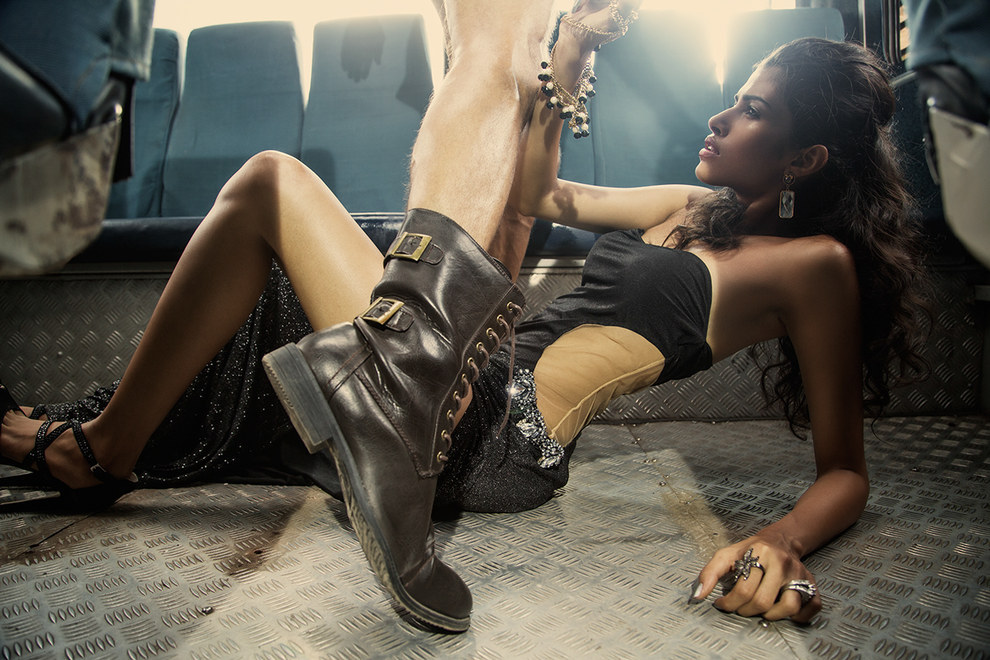No-go areas for artists?

Like most things these days, it started with a Facebook post. A photographer in Mumbai shot a series of photos in a bus depicting the harassment faced by women in public transport. The link to the photos was shared on Facebook. They instantly lit a fuse. It was quickly decided that the photos were a portrayal of the Delhi gang rape case of 2012 and that they were insensitive and in poor taste.
“Moronic”, “twisted”, “fucked up” were the adjectives that flew thick and fast. “One should know where to draw the line,” said one person. “Here's where I would really like the MNS (Maharashtra Navnirman Sena) to do some rampaging”, said another.
What was shocking was that the vitriol came not from political goons as is so often the case in India over art, but largely from artists, photographers and journalists. They created such uproar on the social media that the photographer, Raj Shetye, quietly removed the photos.
It has often been this way in India. The biggest enemies of freedom of expression have been artists, writers and journalists themselves. I have enormous respect for the late Khushwant Singh, but he was the first man (as Penguin’s consulting editor) to suggest that the Satanic Verses should not be published.
There was a legion of Indian painters who rejoiced at M. F. Husain’s harassment by the Hindu right. And only recently, it transpired, from leaked emails, that scholar Ananya Vajpayi tried to instigate someone to ban writer Arundhati Roy’s book, Annihilation of Caste.
Professional jealously is only a small part of the problem. When I spoke to Raj Shetye, he said he was only trying to depict the harassment Indian women face every day on public transport. He said he had been working on the concept for months and had put in a lot of money to get it done.
Critics interpreted the photos as being a representation of the Delhi gang rape. Of course, they are free to interpret whatever comes into the public space but the photographer’s motive, when he is available to explain it, should also be considered and Shetye has told me, as he has told others, that his work was not about the Delhi gang rape or rape at all. But by this time the anger had spilled all over the internet and no one wanted to listen to what he had to say.
Admittedly, his was not an unusually brilliant idea. Scores of short films, including one by the famous director Anurag Kayshap, have already been made on the subject and watched by millions. All these films were in some measure inspired by the Nirbhaya case.
(If I found any fault in Shetye’s images, it was his use of skin and bone models, perpetuating the skinny-is-beautiful stereotype. One can even argue that the execution was bad and that the photos hardly portray the harassment of women).
But had someone mischievously linked the films that have been made on the harassment of women to the Nirbhaya rape, as was done with Raj Shetye’s photos, they could very easily have drawn the same denunciation.
So the question is: are there some emotional no-go areas for artists? I don’t think so. On the contrary, I think it’s incumbent on artists, writers, playwrights, and poets to explore any subject they like for it only broadens our understanding. It’s true that such emotional topics can invite lazy knee-jerk reactions but that is exactly what we should avoid and instead adopt a nuanced approach. But where emotions reign supreme, reason dare not show its face.
From what I have read, those who have protested against the photos seem to believe that gang rape should not be depicted in any way at all, that it amounts to a trivialization of crimes against women and is therefore in bad taste.
This self-righteous indignation is false and hypocritical because when Shekhar Kapur’s Bandit Queen was released, except for (who else?) Arundhati Roy, every critic agreed the film’s centrepiece - the public stripping and the gang-rape - was ‘tastefully’ done.
It did not matter that the rape-victim, Phoolan Devi, who was alive, did not want the rape scene to be shown at all. But the avalanche of praise that the film received drowned Phoolan’s protests completely with some critics calling them ‘tantrums’. But then Phoolan was Phoolan - an illiterate woman from the ravines, a consort of bandits, a woman out on bail. What did she know about these things?
But Nirbhaya, she was one of us.
So not only are there emotional no-go areas but our moral indignation is negotiable. It blows where the wind blows it. And it changes with the times and depends on who is involved. The feminist narrative riding on the Nirbhaya rape suddenly makes us all touchy about the subject now. But in 1994, when Bandit Queen was released, it was okay.
So how does a filmmaker or an artist negotiate this? Perhaps it’s not about them really. Perhaps it’s about us the audience. And what our moral temperature is at that time.
It took a very long time for Indian filmmakers to document Partition. It was an emotional no-go zone because of the horrors that millions went through. But in the ‘60s and ‘70s when filmmakers began to depict Partition, audiences flocked to see the films.
Similarly films on the Holocaust, such as the Pianist or Schindler's List, which graphically depict the Nazi’s slaughter of Jews, were made when the audiences were mature enough to handle them. Today, the films do not offend any Jew.
The fact is books, paintings, films have always depicted, real life events in all their gory minutiae. Raj Shetye’s photos are neither graphic nor gory nor do they show rape. That they represent the Nirbhaya rape was someone else’s conclusion.
Therefore all the noise over Raj Shetye’s photos is very baffling. Or maybe not. We live in times of self-righteous indignation. So Shetye’s protestations that it was not a Nirbhaya Rape depiction, will fall on deaf ears. Like the mob in Julius Caesar, we just need a vent for our moral fury. Anyone would do. It’s no matter if he is not the conspirator. Cinna the poet will always be ripped apart for his bad verses.
(Sanjay Austa is a New Delhi-based journalist and photographer)